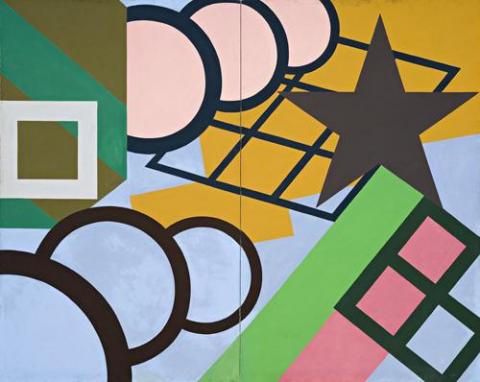OCTOBER, 1967
Dick Watkins
synthetic polymer paint on canvas (2)
243.5 x 305.0 cm (overall)
left panel signed and inscribed verso: Dick Watkins/ ‘OCTOBER’/ 967 right panel signed and inscribed verso: Dick WATKINS/ ‘OCTOBER’/ 67
Acquired directly from the artist in 1969
Private collection, Sydney
The Field, National Gallery of Victoria, Melbourne, 21 August – 28 September 1968 and Art Gallery of New South Wales, Sydney, 30 October-24 November 1968, cat.71 (illus.)
On loan to Monash University, Melbourne, 1973
On loan to The World Bank, principal building, Washington DC, USA
On loan to the Australian Embassy, Washington DC, USA (1995 – 2005) (label attached verso)
Lynn, E., & McCaughey, P., The Field, National Gallery of Victoria, Melbourne, 1968, pp. 85 & 89
In 1968, when the National Gallery of Victoria opened its new building on St Kilda Road, the inaugural exhibition avoided the traditional fare of Arthur Streeton, Tom Roberts and company. Curator Brian Finemore and Exhibitions Officer John Stringer also passed over the new establishment of John Olsen, Leonard French and their contemporaries for an entirely fresh generation of artists. The photographs of the artists in the exhibition catalogue remind just how young they all were. Called 'The Field', the exhibition has now passed into history as a major event and the exhibited paintings and sculpture by Peter Booth, Paul Partos, Clement Meadmore, Dale Hickey, Robert Hunter and others are much sought after. Special among these is Dick Watkins' October, 1967, minimal, fields of unmodulated colour and hard edged, typical of the time. Cool like a Robert Hunter white canvas, variety rather than similarity was the keynote, elegantly shaped canvases of Janet Dawson, Col Jordan and Michael Johnson, rubbing shoulders with the aluminium and Perspex constructions of Michael Kitching.
Abstracts by Peter Booth, the colour canvases of David Aspden and Sydney Ball, and the cut out, inventive sculptural shapes of Tony Bishop and Tony Coleing were displayed in the new, special exhibitions area of the Gallery, walls lined brilliantly in silver. It was something totally different, the curators acknowledging bias in the definition of 'one particular direction in Australian art. It concentrates [they wrote] on the abstractionists, and further restricts itself to an aspect thereof which one is reluctant to confine by terminology.'1 The experience was unforgettable. Controversies raged; egos were bruised; champions argued the cases for and against; and some of the young artists changed directions even during the life of the show. Launched in the hometown of the Antipodeans, it was a bold victory for the new. Watkins' October, like Jacks' Red Painting, was one of the great works in the exhibition. Elwyn Lynn, doyen of the Sydney world of contemporary art, wrote:
'...Dick Watkins - with Ball the most unpredictable of ironic illusionists - uses the same elements as background and foreground; when he encircles the pale blue ground the pale blue looks as much on the surface as the pink in similar circles. October makes this a theme and a grid of diamonds is both composed of background and surface. It is a method that has a kinship with Robert Delaunay's illusionistic overlapping of discs and circles especially in Rhythm 579 of 1934.'2
1. Finemore, B. & Stringer, J., The Field, National Gallery of Victoria, Melbourne, 1968, p.3
2. Elwyn Lynn, ibid, p.85
DAVID THOMAS
